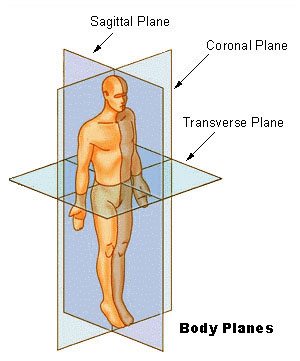One of the most important foundations when learning anatomy and biology is to know correct terminology and how to use it. Today, I will be discussing some of the most common terms used in these areas. It might seem overwhelming or overly complex however, now that I know them, I can’t imagine life without them! I use them to describe almost anything which can be confusing and sometimes hilarious for family and friends who don’t have any idea what I am talking about!
The first thing to remember is what is referred to as ‘the anatomical position’. This is with the patient/specimen lying down on their back with the head pointing upwards, arms by their side with palms pointing upwards and legs straight. Phew! What a mouthful! Let’s get on to learning the of the terms so we can make it easier to say!

To begin you will have to learn the three planes. Like the X, Y, Z axis, there are also three planes; Transverse, Sagittal and Coronal. Now these might sound completely bizarre but once you learn them, they do make sense.
The Transverse plane is a horizontal slice, a lot like the X axis in mathematics. The Coronal plane divides the body into front and bottom pieces, the word ‘coronal’ means ‘crown’ so, if you can imagine a laurel wreath worn by the Romans, it sits behind the ears and points upward towards the top of the head. The Sagittal plane divides the body into right and left halves. These planes are illustrated below:

The clinical importance of these planes is in interpreting radiological images such as MRIs and CT scans as they are slice-by-slice representations of the body.
After mastering the planes we can move onto directions. These are very important for identifying relationships between structures.
Superior refers to ‘above’ structures. For example, the head is superior to the feet.
Inferior refers to ‘below’ structures. For example, the mouth is inferior to the nose.
Anterior means ‘front’, for example, the nose is anterior to the spine.
Posterior means ‘back, for example, the spine is posterior to the heart.
Medial means ‘towards the middle’ and refers to structures that are closer to the midline. For example, the nose is medial to the eyes.
Lateral means ‘towards to outside’, it refers to structures that are farther from the midline. For example, the shoulders are lateral to the neck.
Deep discusses structures that are at deeper layers for example, muscles are deep to the skin.
Superficial refers to structures that are closer to the surface of the skin, for example, muscle is superficial to bone.
These directional terms are very, very useful, not only in medicine and biology, but also in everyday life.
There are also five major relations: Proximal, Middle, Distal, Palmar and Dorsal.
Proximal and Distal are used when talking about limbs and appendages such as fingers. If you consider your fingers, the joint closest to your hand is the proximal joint. The distal joint is the joint farthest away from your hand.
Middle, the middle joint is the one in between the proximal and distal joints.
Palmar refers to the palmar surfaces of the hands and the feet, that is, the palm of the hand and sole of the foot.
Dorsal, the dorsum of the hands and feet are the backs of the hands and feet.

Finally, I would like to talk about movements. It is easiest to learn by doing the movements yourself.
Flexion – decrease in the joint angle, if you bend your arms you are flexing your elbows.
Extension – increase in the joint angle (straightening). If you straighten your arms from being flexed, that is an example of extension.
Abduction – raise your arms to the sides. (I think of it like you’re taking your arms away i.e. kidnapping/abducting them)
Adduction – lower your arms back to your sides (you’re ‘adding’ your arms back to your body? Weird explanation, I know)
Rotation is either internal/medial or external/lateral. To internally rotate your arms, bend them at your sides like you’re pretending to be a robot and rotate your forearms to hug your tummy. To externally rotate them, swing your forearms out so that you look like a bizarre penguin.
Supine/Prone refer to whether you are lying on your front or your back. Supine is where you are lying on your back and prone is where you are lying on your front.
Supination/Pronation refer to your forearms. Supination is having your palms facing upwards (I like to think of it as tying to hold a bowl of soup.) whereas pronation is palm downwards.
Inversion/Eversion is in regards to your ankles. Inversion is here you roll your ankle outwards (more common) and eversion is where you roll your ankle inwards.
Dorsiflexion – flex your foot so your toes are pointing upwards.
Plantarflexion – flex your feet so your toes are pointing downwards like a ballerina.
All those movements get easier to remember with time and practice. To make it clearer, they are demonstrated here in the video Anatomical Terms of Movement in YouTube.
So now let’s go back to my original explanation of the anatomical position and change it to use some of our terms: The patient is supine with their arms and legs adducted and their arms supinated.
How easy was that?!
I hope this was helpful to you and if you have any questions please leave a comment below.

This site is very amazing………Lots of hard work gone in to this and made the concepts of Biology – Anatomy, Physiology , Pathology –made very easy to understand………through videos (very useful), through powerpoint presentations and adobe reader notes………….
Truly Amazing …………would like to recommend to all my relatives and friends…………….
Awesome very organized and clearly presented! You have a talent for instruction, and we appreciate your effort to help people learn very challenging material!
Hello! This post could not be written any better! Reading through this post reminds me of
my previous room mate! He always kept chatting about this.
I will forward this post to him. Fairly certain he
will have a good read. Many thanks for sharing!